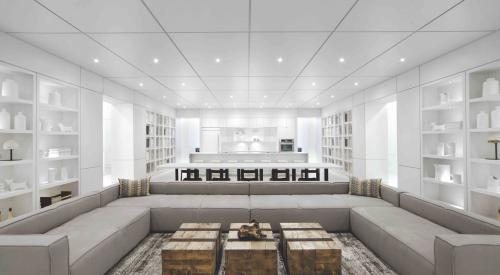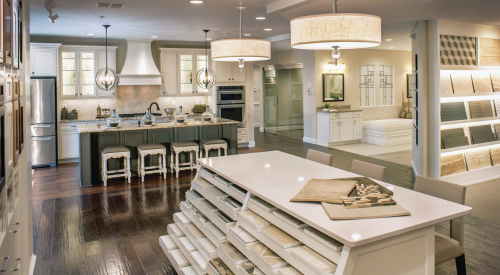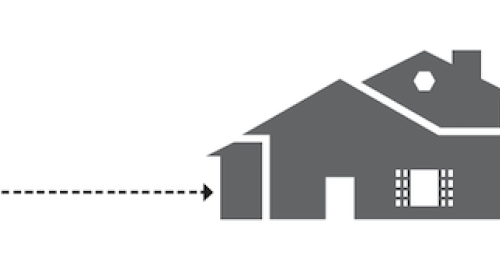|
A man walks into a Burger King — true story. "And two guys were in front of me in line. And they both wanted it 'their way.' One didn't want pickles; the other one didn't want mayonnaise," he says. "Guess what? Both burgers came out wrong and had to be thrown away. Now if Burger King can't do it right with a piece of meat, a bun and some ketchup... why the hell would builders think they can do it building a house with more than 300,000 parts in it?"
Chuck Shinn, president of both Lee Evans Group and Shinn Consulting, didn't enjoy that trip to the trough, and the thought of builders "giving customers whatever they want" gives him indigestion because he knows they're also giving away the store.
 |
| Both regional design studios and on-site selections strategies can work. |
Builders need to serve two masters: their customers and their financial needs. Most people in the industry agree that too much effort goes into selling options, and too many builders give them away for prices below what the market will bear. Builders can make money on upgrades, though. But it takes a good understanding of how to control the selection of options, using a well-managed set of predetermined choices. So forget the notion that they're just table stakes meant to appease customers who will compare you to the proverbial "guy selling houses down the street."
Profits Before VolumeFew builders admit to losing money by selling options, but they may be doing so when they leave money on the closing table. Others intentionally keep margins low on upgrades in order to grow volume and market share, something Shinn decries.
"When you choose volume... you're not getting the margins. You're wasting opportunities. You're spinning through your land, then you have to go out and buy new land at new prices," he says, adding that this holds true whether a builder is "chasing volume at 50 units, 100 units or 50,000 units."
"You should always structure your options and upgrades as aggressively as possible," says John Rymer, Tampa, Fla.-based president of Rymer Strategies. "This is particularly true when land is scarce and it's hard to replenish the inventory you're selling. Instead, you need to focus on how to get the most dollars out of every customer who has agreed to buy."
The same holds for markets with clear land approval pipelines but low volume potential — or a slowdown looming. "The economy's not going to stay this good forever," says Dave Weiss, owner of Weiss Homes. He sold 250 entry-level and move-up homes in 2005 in a market he says "hasn't been much of a growth market. So our goal has been to increase our revenue without increasing our volume."
Several builders report the level of options sales per housing unit at approximately 20 percent. Shinn says 30 percent is more appropriate. First, he says, a builder should identify and include "customer wants" in standard inclusions. "The rest should be priced to meet perceived value — not based on cost."
Marginal ThinkingProfits on options range widely based on that perception and on availability. Builders have little choice but to nearly give away easily sourced commodities that buyers can comparison shop, driving margins on those items as low as 10 or 20 percent. But options range from the simple all the way up to construction changes such as "changing a slider to French Doors, eliminating a closet in the third bedroom and turning it into more square footage for a den," says Rymer. "Some builders don't want to do this category of option at all. Others don't necessarily encourage it, but if a buyer wants it, there may be a 100 percent markup, because they can get it."
Shinn thinks builders are missing the boat when they don't actively market such changes and charge a premium. He cites a bump-out that "might cost two feet of wall and two feet of carpet to build. It's not that expensive. But you can charge anywhere from 200 to 500 percent for that, because it's a high-value option."
The caveat about bump-outs, Shinn says, "is that if you allow the customer to add one in the back of the house, it's because you have a specific design for a bump out in specific places in the house. And if it's a three-foot bump-out, it's not going to change to two or four feet." This is not a custom option. It has to be pre-estimated, priced and cataloged to eliminate back-and-forth negotiations and internal inefficiency.
Controlling ChoiceThe same principle applies to single structural elements or whole groups. For example, multiple configurations for master bedrooms/bathrooms, extra bedrooms in bonus spaces and kitchens with options for family areas and recipe nooks. Such seemingly custom changes are neither custom nor changes, but valued choices that must be pre-estimated, priced and included in the company's offerings. This allows structural items to be chosen at contract signing as part of the floor plan.
Customers can choose non-structural details, from floors to cabinets to whole-room trim, appliance and cabinet packages, in much the same way. Meagher has her clients do this to satisfy buyer's wants in a way "that doesn't overwhelm them and drag the process down." She calls this "controlled choice."
She hopes to combat a false belief by too many builders that customer satisfaction depends on "offering them everything they ask for." She continues, "In that quest for customer satisfaction, builders can really hurt themselves by offering way more choice than they need to, even when they cannot handle it, procedurally."
When creating a profitable and efficient customer selection process, Rymer says "the most important role senior management can play is to have a clear and concise direction and vision on what role options and upgrades play in the company." Without a clear mandate for departments to get along and make sure operational and computer systems do the same people will work at cross-purposes.
For example, sales office and design studio personnel will naturally push their "more is better" attitude. "Sales loves the ability to sell a personalized, differentiated house, exactly the way the buyer wants it," Rymer says.
But construction personnel fear creating paperwork snafus, variances, supplier delays and nightmare scenarios "like the 'special flooring' that adds two weeks to the schedule," Rymer says. Such disorganization can blow performance reviews and bonuses, inflicting undeserved pain on the department. Likewise, more options without more staffing in purchasing and estimating can strain efficiency as well as morale.
Do you Need a Design Studio?It seems the "have it your way" attitude applies not just to customers but also to builders. Selling options can succeed whether run out of a model home sales office, or handled in a full-fledged and fully staffed design center. The key, again, is how well a company manages its processes and how the sales office is run. Experts agree that sales office personnel are qualified to handle floor-plan specifics at contract signing, but specialists trained in available options should be on hand for the details. This is true for builders who handle selection on-site or in a design center. It also holds true whether the selection process is handled in a single meeting lasting three hours or a phased set of multiple meetings.
Meagher says builders and buyers "are no longer settling for a 10 × 12 selections room in the sales office; they're looking for a design center experience." She is committed to having builders invest in centers as well as the training it takes to choose between a dizzying array of high-performance materials and technologies.
Weiss Homes is a believer. Model home displays worked fine until 1997 when the company put a 2,500 square-foot studio space in its home office. Then last June, Weiss opened a $750,000, 10,000-square-foot showroom. Average sales price per house has increased six percent with as much as five percent of that directly attributable to options sales.
In contrast, Lakewood Homes in suburban Chicago has seen "continued increases in our level of options sales in the last few years," Chris Shaxted, executive vice president, says. Volume has grown steadily to top 2,000 units in 2005, and while the company won't move so much as an electrical outlet that's not in its pre-estimated catalog, it consistently ranks at or near the top of its market in overall satisfaction as well as design center criteria, he says. And the company doesn't have a central design studio. "We haven't completely figured that out, except to say that we're very convenient for customers and we're knowledgeable," Shaxted says.
Convenience is one of the key factors driving a Lakewood competitor, Neumann Homes, to announce it will phase out its large, regional Dream Centers in the Midwest and Denver-based Western division this year. The company will go back to on-site selection based on three key findings from internal and J.D. Power research. Larry Wisdom, Midwest regional president, says the company looked "very deep into the J.D. Power results of what customers are saying" to conclude that customers want:
- Convenience at the point of sale: A central studio can consolidate trips to various supply houses, but not if the studio itself is too far from the customer's home or point of sale.
- Fewer people to deal with: But people they trust for a less complicated buying experience.
- Appropriate choices: But not things they can't afford or won't fit in the home.
It appears that builders "have come out on top with and without centralized design centers," Paula Sonkin, J.D. Power's executive director of real estate industries, says. Meagher notes "some validity" to the notion that some builders can profit either way. Bullish on dedicated design centers, she still believes most builders need to differentiate themselves to maximize profits and can "make it worth the buyers' while" when they properly set expectations and offer superior education and service.
Next StepsFor Neumann Homes, the phase out of its design center isn't a retreat because, as Wisdom says, "we're able to take what we've learned about process operations excellence and computer technology, and put that into separate design galleries at the individual community."
Instead of a sales office associate "laboriously taking everything down," a specialist will guide the buyer as selections are entered into the company's integrated information system.
It's a bit of an experiment in a world where design centers still dazzle, but Wisdom is certain that this "downsizing ... of the buying experience will delight the customer" and boost internal efficiencies.
Somewhere, a builder is building sub-regional mini-studios in each quadrant of a major market. Also somewhere, Shinn is telling another builder of the ultimate, untapped customer convenience: "Do it on the Internet! Let customers make selections out of their homes."
|












